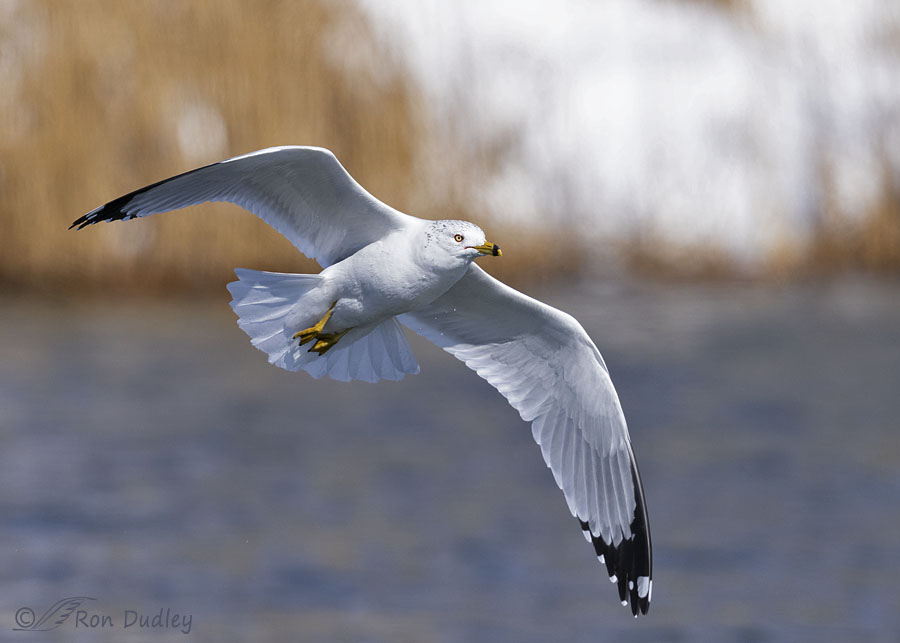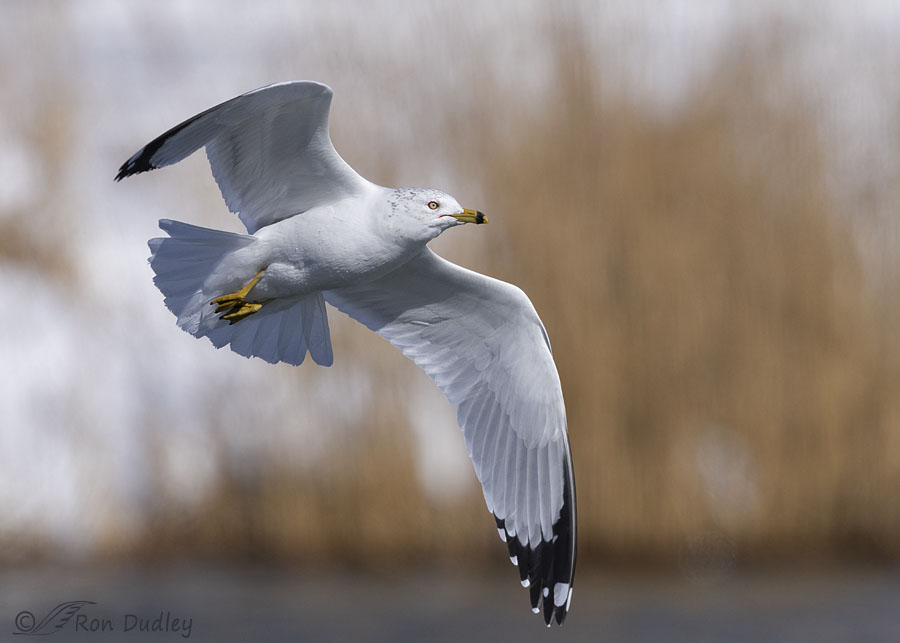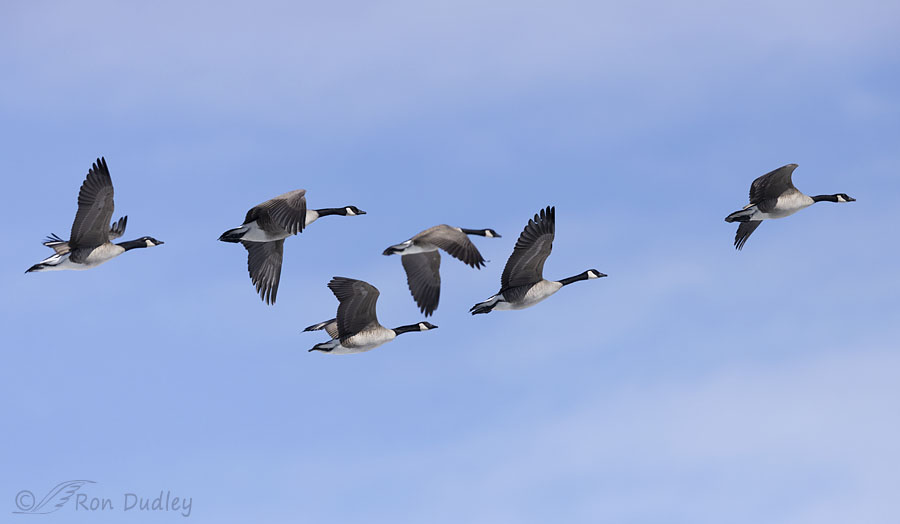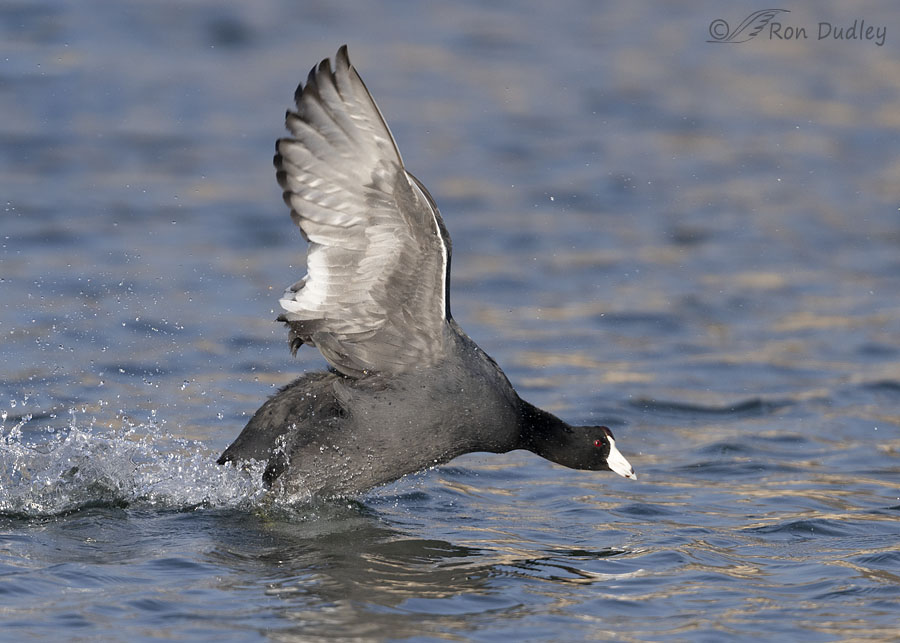Four recent photos of three species that deserve a little more respect, at least in some circles. The first three were taken yesterday and the last one 13 days ago.

1/5000, f/6.3, ISO 500, Canon R5, Canon EF500mm f/4L IS II USM + 1.4 tc, not baited, set up or called in
A Ring-billed Gull cruising low over the water as it was looking for food to steal from some other bird.

1/5000, f/6.3, ISO 500, Canon R5, Canon EF500mm f/4L IS II USM + 1.4 tc, not baited, set up or called in
The same gull, three frames later.
By 1920 this species was nearly wiped out by human persecution and development but since then they’ve made a remarkable comeback, to the point of being considered a pest in many areas. Large populations of gulls, including this species, in urban and suburban areas can negatively affect airline flight safety, human health, and agricultural production. Their tendency to frequent garbage dumps and parking lots in large numbers does nothing to improve their public image. Nor do their kleptoparasitic habits.
Bird photographers, including yours truly, have a tendency to ignore Ring-billed and other common gulls – a habit I’m trying to break with at least some success. Like most any bird they can be interesting photo subjects, especially in flight.

1/8000, f/6.3, ISO 500, Canon R5, Canon EF500mm f/4L IS II USM + 1.4 tc, not baited, set up or called in
Canada Geese circling over a pond as they try to decide if they want to land on it. They didn’t.
In recent years Canada Goose populations have increased so dramatically in many areas, including Utah, they’re considered a nuisance. Public park and golf course managers get massive numbers of complaints about goose poop underfoot so both lethal and nonlethal methods are used to control and limit their numbers. About 2 million Canada Geese are “harvested” annually by hunters in the U.S. alone but even that has little effect on their numbers. The “goose problem” is especially acute in winter because many Canada Geese have lost their migratory habit.
As a photographer I may ignore most gulls but I don’t ignore Canada Geese, especially in flight.

1/4000, f/5.6, ISO 640, Canon R5, Canon EF500mm f/4L IS II USM + 1.4 tc, not baited, set up or called in
An American Coot doing what coots do – chasing another coot across the water.
Coots are raucous and quarrelsome birds whose presence is often announced by loud cackling, grunting, and croaking calls which many folks find unappealing. In some areas their populations are so dense they cause considerable crop damage through depredation and they can be a nuisance in public areas such as golf courses, local parks, commercial developments and suburban residential areas. Shooting, netting, and application of sedatives/anesthetics have been employed to deal with these problems. Coots don’t even have much appeal for hunters because their meat is considered to be inferior to that of ducks. Hunters often disdainfully refer to coots as “mud hens”.
Bird photographers tend to ignore coots but in that regard I’m an exception. I think their pugnacious habits can make for some really interesting photos.
But then I’m a behavior kinda guy.
Ron


So glad you give tribute to the “ugly” and obnoxious, Ron!
I can set my watch by the gulls flying overhead between the K-8 2 blocks north and the HS 2 blocks south. I know exactly when recess, lunch, nutrition, etc. are.
Really like the ring-billed!
Thanks, Arwen.
I think you know that I like the common, ignored, and often unlikable birds. They have so much to offer. If we ignore them we miss so many fascinating behaviors. Birders typically ignore robins. They’re put on a list as being present but no more attention is paid to them. Many people don’t even realize they have a split eyering or white streaks in the throat because the robin is to common to pay attention to those details. Coots are not well-liked but they have fascinating behaviors and interactions with other species. We tend to dislike starlings but from a biological point of view, they have some really interesting adaptations that most people don’t want to take the time to learn about. I recently wrote an article about birds and other animals we find dislikable for various reasons. Even mosquitos are important as pollinators so, much as we dislike them, they are not all bad. And with Ring-billed Gulls, most people are not aware that any large colony of them will almost certainly have some lesbian pairs. They obviously need to mate with a male but form some females form a pair-bond with another female, both laying eggs in one nest and incubating and defending that nest and later the young. I found some people who want to put their human morals on that and are repulsed by this. I find it fascinating. I will always be delighted to look at your photos of common or ignored species. Male Western Tanagers are gorgeous but the duller females and other less colorful species have much to offer us if we only take the time to observe and learn.
You made the point better than I did, Dan. At least in some ways.
That’s fascinating about lesbian Ring-billed Gulls.
Dan, my daughter had a pair of mated female white ring-neck doves from our rehab. They built nests, laid infertile eggs and where the most caring parents to numerous orphaned mourning doves whom they raised for the rehab. Put a male dove into their enclosure and the two females would wing-slap him to death.
Quite a story, April. Thanks for sharing it.
Thanks April. I just happened to check back and saw your story. Interesting. My article included just such things. Things that too many people want to make moral and inappropriate judgements on. Female-female pairings in birds and other animals, species that actually change sex or males imitating females. I also include such animals as cowbirds or cuckoos who lay their eggs in other birds nests and let them raise the young. Mosquitos and wasps also have important biological roles. Nature makes no moral judgements it simply is and it’s all fascinating.
There’s certainly every imaginable sexual behavior in the Animal Kingdom. As we are animals, it make sense that sexuality is highly variable in us as well. (And if those people really want to get their proverbial knickers in a twist, they need to study breeding behaviors in fish! )
)
Our rehab imprinted coot, Coot, Coot, was adorable but feisty. Yes I did the mirror test on him, of course all he wanted to do was kill the intruder. Behavior is great to watch.
“of course all he wanted to do was kill the intruder”
Of course!
That must have been something to watch. I’m pretty jealous that you got to hang out with a coot, April.
A wonderful series with your usual astute comments.
Canada Geese are sometimes regarded as a pest species down here in NZ.
Thanks very much, Gary.
A study in Nature’s trip to the Jewelry/Accessory counter at the mall.
The gull gets a black nose ring and a little something for the tips of those gorgeous white wings. A white chin strap for contrast on that elegant goose head. And a red ruby with white enamel bill to finish off the under-appreciated coot. Jewels all, to be sure!
Love your approach, Carolyn!
All them pesky birds gettin’ in the way of us humans. Just give it some time and we’ll get rid of ‘em. And us, too. Oops.
Out of the mouths of babes, Lyle. Or in this case, an old guy…
High school football teams here refusing to practice because they are sliding in Canada Goose poop on the fields !! They have become a huge nuisance here in New England !!
Interesting about your football teams, Gary. Though I’m not surprised.
Gulls, not sure what kind, are very common in GF – a few here. Were many years ago that would follow the tractors doing summer fallow looking for mice/worms – not so much now with no-till. Canada Geese have become an issue, mainly in town, as many are wintering over rather than migrating. Haven’t seen a coot in many years – more common in WMA’s and no, duck hunters don’t appreciate them….. Nice shots!
Nice shots! 
Chinook on the way………
“Haven’t seen a coot in many years”
That surprises me, Judy. I wonder why.
Could be because they aren’t on Belt Creek and I’m not “paying attention” when in other areas…….
Love this post. I have always been a champion of the ignored and underappreciated. Excellent photos as always and especially like the Coot.
We get a flock of Ring-billed Gulls in two of our lakes every year and I really look forward to their arrival. Our Canada Geese are now year round and we have somewhere in the neighborhood of 350 to 400. They reside mainly in two lakes and on the golf course where I live. And lastly we have lots of Coots mostly at our two largest lakes. Unfortunately they often become food for the Harriers and Prairie Falcons and occasionally for our Eagles,
I also count Robins and Mallards among the ignored.
“I also count Robins and Mallards among the ignored”
As do I, Everett. Especially Mallards.
Well, every dog has it’s day. And you provided the forum. Nevertheless, a morning delight.
We don’t see too many honkers where I live, so seeing a flight overhead and hearing that sound is a real treat.
Michael, there are many hundreds of geese that hang out in the park and golf course near my home. I really enjoy their flights over my house this time of year.
Love the Geese in flight photo! They are in the perfect arrangement – as if the were choreographed!
I love seeing all the birds you mentioned and have taken some nice photos of all of them too. Ring-Bills can be especially entertaining when they are going for crabs.
“They are in the perfect arrangement”
Joanne, for me, groups of geese in flight have to have good separation for me to really like the photo. That’s one of the things I enjoyed about that photo.
Thank God, I was afraid it was going to be starlings and house sparrows…but those danged Canadas are everywhere.
I think many biologists are behavior sort of people, I know I am.
I will never forget laying down in a field watching a Red Fox hunt. When he caught my scent or movement, instead of running he simply sat down and looked at or simply watched me for awhile. For me that was a fun time, but I’m weird.
Love your shots!
Thanks, Dick. I think we both agree – pretty bird photos only go so far.